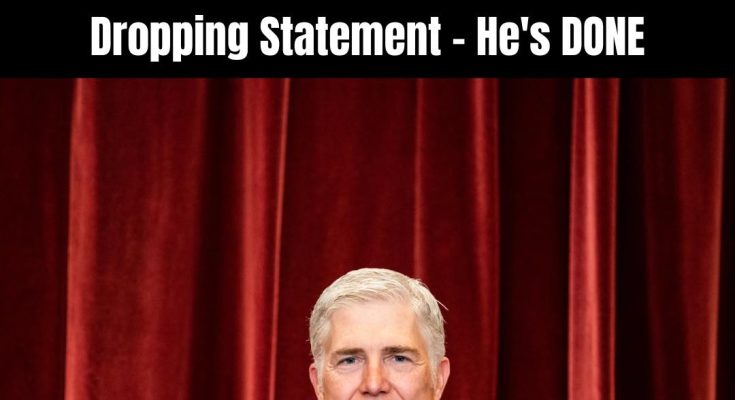A constitutional crisis is brewing within America’s federal court system as the nation’s highest judicial authority confronts an unprecedented pattern of defiance from lower courts. The confrontation has reached a breaking point, prompting one of the Supreme Court’s most respected conservative justices to issue a stern warning that strikes at the heart of judicial hierarchy and constitutional order in the United States.
The Explosive Warning That Shook the Federal Judiciary
Justice Neil Gorsuch, appointed by President Donald Trump, delivered a scathing rebuke to lower federal courts on Thursday that has sent shockwaves through the American legal system. His extraordinary warning came as the Supreme Court handed the Trump administration a narrow but significant victory in a closely watched case involving federal research funding and diversity programs.
“This marks the third time in a matter of weeks this Court has had to reverse a lower court on an issue it had already addressed,” Gorsuch wrote in a stinging concurrence joined by Justice Brett Kavanaugh. His words carry particular weight given his reputation for measured judicial temperament and careful legal reasoning.
The justice’s frustration was palpable as he continued: “Lower court judges may sometimes disagree with this Court’s decisions, but they are never free to defy them.” This statement represents more than legal instruction—it constitutes a direct challenge to what appears to be systematic resistance within the federal judiciary to Supreme Court authority.
The timing and tone of Gorsuch’s warning suggests that the Supreme Court views the current situation as a fundamental threat to the constitutional structure of American government, where the hierarchy of federal courts has traditionally ensured consistent application of the law across the nation.
The Case That Triggered Constitutional Confrontation
The immediate catalyst for Gorsuch’s unprecedented warning emerged from a complex dispute over federal research funding that illustrates the broader ideological battles reshaping American institutions. In a narrow 5-4 decision, the Supreme Court allowed the Trump administration to cut millions of dollars in National Institutes of Health (NIH) grants that supported projects tied to diversity, equity and inclusion (DEI) initiatives, gender identity research, and COVID-19 studies.
This ruling represents a significant victory for the Trump administration’s efforts to dismantle what it characterizes as ideologically driven federal programs. The NIH, recognized as the world’s largest source of public biomedical research funding, will no longer award grants based on race or DEI objectives under this decision, fundamentally altering how federal research dollars are allocated.
The case arose after a federal judge in Massachusetts directly defied a Supreme Court ruling from earlier this year that had already permitted Trump to cut similar DEI-related grants. This act of judicial rebellion prompted a coalition of 16 Democratic attorneys general and public health groups to file suit, alleging systematic discrimination against minority researchers and LGBTQ+ community members.
The Massachusetts court’s decision to order continued payments despite clear Supreme Court precedent represents exactly the type of judicial defiance that has prompted Gorsuch’s stern warning. The lower court’s actions suggest either a fundamental misunderstanding of judicial hierarchy or a deliberate attempt to undermine Supreme Court authority through procedural manipulation.
The Decisive Vote and Judicial Alignment
The Supreme Court’s 5-4 split decision revealed the complex dynamics currently shaping the nation’s highest court, with Justice Amy Coney Barrett providing the crucial deciding vote in a carefully calibrated ruling that addressed multiple aspects of the dispute.
Barrett joined conservative Justices Clarence Thomas, Samuel Alito, Gorsuch and Kavanaugh in terminating the NIH grants, demonstrating the conservative majority’s commitment to dismantling DEI-related federal programs. However, in a move that illustrates the nuanced nature of judicial decision-making, she sided with Chief Justice John Roberts and the three liberal justices—Sonia Sotomayor, Elena Kagan and Ketanji Brown Jackson—to leave intact a lower court’s decision scrapping NIH guidance documents that described the agency’s policy priorities.
This split decision reflects Barrett’s emerging role as a swing vote on certain issues, even within the Court’s conservative majority. Her willingness to break with conservative colleagues on the guidance documents suggests that she distinguishes between direct funding decisions and broader policy communications, a nuance that may prove significant in future cases.
The liberal justices’ unified opposition to cutting the research grants underscores the deep ideological divisions within the Court on issues related to diversity, equity, and federal funding priorities. Their position reflects broader Democratic concerns that the Trump administration’s policies constitute systematic discrimination against minority communities and researchers.

